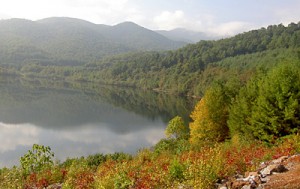The first 2011 sojourn into the Town of Waynesville’s 8,000-plus acre watershed occurred last Saturday (June 11). The town has been sponsoring and coordinating a couple of guided hikes into the watershed each year since 2007. It’s a way for residents and other interested parties to see this wonderful resource that has been placed in a conservation easement to insure the town has an ample supply of high-quality drinking water for generations to come.
For those of you just awakening from a seven-year coma, there was a bit of a stir back then regarding some of the attributes of the easement. Some areas of the watershed are in a “forever wild” easement – which basically means hands off. However, a large portion of the watershed is in a “working forest” easement – which gives the town the authority (and perhaps even the directive) to actively manage the forest. And “active” forest management includes logging – a term that, justifiably, sends shivers up and down the spine of many environmentalists/conservationists.
There was an immediate hue and cry (some perhaps politically prompted) regarding the motivation for and the consequences of logging in the watershed back in 2004. While emotions fer and agin logging the watershed ran rampant at coffee shops and in “letters to the editor,” the town proceeded in a rational way by creating a public oversight committee and commissioning a study of the condition of the watershed and the creation of a management plan for the watershed. I believe it was during this laborious process of studying the watershed and hashing out the details of a management plan that the idea of hikes into the watershed, where citizens could get a first-hand look, germinated.
The hikes have been well received and this year’s first hike was no exception. Alison Melnikova, assistant town manager and watershed hike coordinator extraordinaire, had to halt registration at 65 for this hike. Forty-nine of those registered showed up!
I must say we were quaking in our boots a bit concerning the logistics of providing a quality experience for 65 hikers. But a big shout out to Dan Callaghan, Forest Stewards’ Americorps apprentice forester, Ed Kelley, photographer/naturalist and Michael Skinner, executive director at Balsam Mountain Trust for answering the frantic pleas for help and volunteering their time to help create a quality outing for participants.
Dr. Pete Bates, professor of natural resources at Western Carolina University, president of the board of directors of Forest Stewards and lead researcher of Waynesville’s Watershed Management plan, has always been one of the leaders for the watershed hikes. In the early years Bates’ groups never got in much of a hike due to all the Q and A regarding the management plan. But Bates is a stalwart and convincing supporter of the plan and the science used to create the plan and is always happy to discuss the merits and objectives of the watershed management plan.
This year Bates got to stretch his legs and obviously had a good hike: “Overall I thought the hike went well. I had about 20 in my group, and we did about an eight-mile, out and back from the water treatment plant. We saw a variety of forest communities ranging from white pine plantations to rich coves to northern hardwoods at about 4700 feet elevation. For those in my group, it was a great opportunity to see the watershed and learn more about the town’s efforts to care for its forests.”
We took advantage of Ed Kelley’s photographic skills by offering a last-minute opportunity for those interested in nature photography and had about a half-dozen takers. According to Kelley, “…we did a lot of close-ups and exercises in observation, looking for subject matter, addressed some creative things you can do with your camera when there’s not a lot of great photo subjects, and I answered some technical questions about photography, as well as tried to get them to thinking about using what they saw along the way to plan future photo outings (i.e. a remembering the location of a group of staghorn sumac that will be blazing orange-red in the fall.)”
Michael Skinner kind of floated between groups. Fortunately, he was with my group, with his bird-app, when we had blackburnian warblers overhead. He was able to play the song, coaxing the blackburnian down where most people got good looks. Skinner noted, “I had a few in the group suggest we do this more often.”
As for me, I was doing my usual grand job of spreading misinformation. We encountered some yellow mandarin (not in flower) and I was trying to think of the other common name for it when “cucumber root” jumped out of my mouth. I have no idea why. The plants look nothing alike. There is some similarity in the flowers but even that’s a stretch. I guess I’ll write it off as a senior moment. The other common name for yellow mandarin is fairybells – sounds a lot like cucumber root doesn’t it.

